種族影響
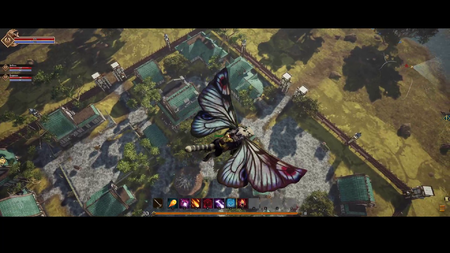
We have essentially sets that exist across all races; and each race that dons those armor sets is going to have their own racial influence on the presentation of those particular sets. So that's something that's unique in how each of the races get diversified. Additionally, the more that one particular race contributes to a node's development, it's going to manifest in that particular node's architectural influences. You're going to see the architectures of those races become manifest within the nodes as well: That's another way that we diversify each race and we present each race's culture in the game as through those architectures, through those props that exist, through the tailoring of the armor sets that the NPC might wear, to the different factions that exist. Factions will have their own affiliation with different races as well. Each race will also have some different nomenclature when it comes to the lore, or comes to locations in the world. They're going to have their own language influences as well: The way they speak is something that's going to be distinct between races; when you have dialogue trees with particular NPCs. So all of those things really go into setting an immersive world where the cultures have their own identity.[2] – Steven Sharif
Cultural influences manifest in many ways, from node and gear aesthetics to NPC languages and lore.[2][3][4]
- 裝備外觀 of certain armor sets is influenced by the player's race.[2]
- 節點佈局與風格 is influenced by the race that contributes the most to that node.[2]
- There is an attrition and that attrition on experience and influence is heightened based on the performance of the race in the world. So if all these nodes are Orc nodes then their attrition rate is very high to compete with the cultural establishment of new nodes because they have more influence in the world and a popular opinion is against them in their outlying regions that they do not have influence in.[5] – Steven Sharif
美術影響
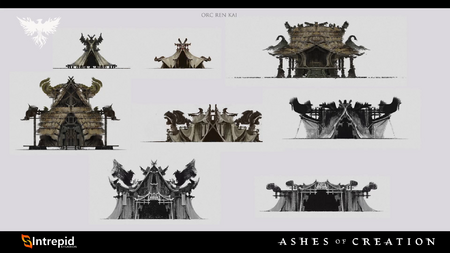
Character races are super important. These are the choices that we make at the onset of our adventure in an MMORPG: what race- not just mechanically aligns with our decisions, if those races have game mechanics behind them from a stat perspective, but visually and culturally and historically: What are these? What do these races represent? So it's important that visually they're distinct. And everyone's seen fantasy games do Elves, so everyone's seen them do Humans, everyone's seen them do Orcs: There's an established expectation almost behind what these traditional fantasy races represent; and there's a risk, because whenever you're creating a new IP or a new story or a new world- a new Universe; a realm in which things don't have to always be the norm, you can take a little bit of creative liberty to redefine some of the aspects of a particular race; and that can be a good thing, because it's something that is new to players. It's something that is unique to the realm that we're building- the surroundings that you have. So what we wanted to do was push a little bit more on the unique side of what the Py'rai would look like from a visual perspective.[7] – Steven Sharif
- Aelean architecture has a French medieval influence.[8]
- Dünir have a Nordic cultural influence.[9]
- Empyreans have a Greco-Roman imperialistic feeling.[10]
- The Kaelar have a European influence.[11]
- The Niküa have a Polynesian influence.[12][10]
- The Py'Rai have a Navajo Native American influence.[10] Py'Rai architecture has a woodland inspiration.[13][14]
- Pyrian architecture has a Greco-Roman influence.[15]
- Ren'Kai architecture has an Asian influence.[6]
- The Vaelune have a Middle Eastern influence.[16]
- The Vek have a Mesoamerican influence.[16]
- You will see in the different races that are available from a player character standpoint a lot of different influences that reflect many cultures in the world: Not just European, not just Africa, not Mesoamerican. These cultures are going to be present in many of the races.[17] – Steven Sharif
- The idea is just to find a base component in the real world as a starting point and then to begin to fantasize.[8] – Steven Sharif
節點佈局與風格
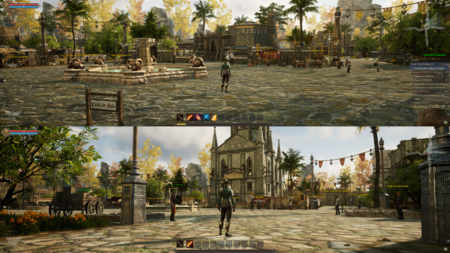
The layout and architecture within a Node’s development area are determined by influential race. For example, a stage 3 Node with the majority of player contribution being Py'rai would have a Py'rai village with Py'rai architecture. Most NPCs would be Py'rai elves, and offer questlines within the Py'rai narrative.[18] – Margaret Krohn
Each player’s contributed experience is flagged with their character race and other identifiers. When a Node advances, the race with the highest experience contribution determines the Node’s style and culture. This style and culture change can happen at every Node Stage. For example, if a Node advances to Level 2 - Encampment Stage and 51% of all experience was earned by Ren’Kai players, the Node will be a Level 2 Ren’Kai Node. If that same Node advances to a Level 3 - Village Stage Node, but the Py'Rai contributed 62% of all the experience earned, then the Node will be a Level 3 Py'Rai Node.[4] – Margaret Krohn
節點佈局與風格 is determined by several factors:[19][20]
- The way that the node system is built is that they can exist across a spread of 18 biomes, but at the same time have to represent the cultural influence of these cultures that are intrinsically a part of a specific biome.[21] – Steven Sharif
- Environment (biome) and location of the node.[21][19][20]
- Nodes will adjust the local topography to fit the aesthetic and mechanical requirements of the node.[22]
- Currently the way that the platform system is set up, is it's capable of adjusting the topography of the node's footprint, regardless of the surrounding terrain. So the reason for that is we want to have flexibility in the presentation of the node's layout and how it is essentially both from an aesthetic standpoint as well as a mechanical standpoint with node sieges- how it's constructed and that construction should have the ability to take on a variance of different types of topography. So it shouldn't be dependent on the surrounding area. Now that's not to say that the surrounding area isn't going to have some influence over. So for example... we're experimenting a little bit with the platform tech and putting up a node up against the side of a mountain or on the edge of a cliff or something that has a beautiful vista. Those are things that we're going to test out obviously as we continue to work on the node tool and how that platform system works, but the idea is to have the node independent of the surrounding terrain.[22] – Steven Sharif
- Some parts are determined by the area it's in. Some parts are determined by the type it is. Some parts are determined by the race it is; and then the rest of it is determined by the mayor.[20] – Jeffrey Bard
- Race that contributed the highest percentage to the node's advancement will alter the racial appearance of its buildings, NPCs, and props.[2][23][19][4][20][24][25]
- All nodes, whether they're associated with a castle or associated with normal node structure, has cultural influences that replicate over to the buildings that are produced and the NPCs that are present.[27] – Steven Sharif
- The rest is determined by the node's mayor.[20]
- It should be possible for a node to complete several building projects within a mayor's one month term in office.[28]
- Q: How long would you say it will take players on average to fill/build up a node completely from wilderness to metropolis?
- A: It's one thing to get a node to a certain level: it's another thing to develop the node; and I can't really give you an on-average expectation, because there's a lot of variables at play. There's how many citizens does the node have attracted to it; what's the type of traffic that the node is attracting to it based on things like its tax rates, or the specialization that it chose to spec into, based on the building types it's chosen to build. All of those things are variables that can affect the quote-unquote "average build-out time" of a particular node. So it's difficult to give you an average when there's so many variables along those lines. But the idea is that if there is a particular project that players are interested in in developing based on the node stage, that they would have the ability to complete several of those projects as within a single term of a mayor; and a term of a mayor is one month.[28] – Steven Sharif
節點發展
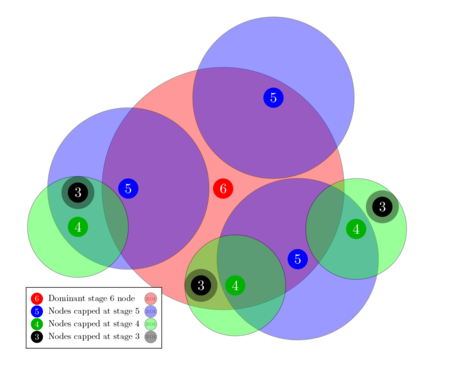
從第三階段起,節點升級時,鄰近的節點會被納入成附庸節點。附庸節點是由上級節點擁有,且等級必須低於上級節點一級。這代表上級節點升級後,附庸節點才能升級。附庸節點會提供大量經驗給其上級節點,且同時可以有自己的附庸節點,但條件是這些節點也位於其上級節點的影響區域內。附庸節點受上級節點的政府、同盟、戰爭、稅務和貿易影響,且可以獲取聯邦援助。附庸節點不能對上級節點或自己的附庸節點宣戰。附庸節點的公民亦受上級節點的外交狀態約束。[18] – Margaret Krohn
玩家 (公民或非公民) 於節點的影響區域內進行活動 (任務、採集、團隊戰鬥等) 時,將有助該節點發展,提升節點至更高階段。[4][30]
隨着節點發展,其發展區域將會是出現文明的地方。節點發展至不同階段時,其發展區域內將會出現不同的建築物、NPC 和服務。節點等級愈高,發展區域便會變得愈繁盛,人口亦會變多。發展區域也會根據節點種類 (經濟、軍事、科技、神聖) 而變化。未來我們將會更詳細介紹每種節點種類。[4] – Margaret Krohn
隨着節點發展,將會有獨特遊戲內容解鎖,但其影響區域會同時擴大,限制相鄰節點的可發展等級。[31]
- 第一階段發展需時短,讓玩家可以使用售賣、存放物品等 NPC 功能。[32]
- 節點等級愈高,其影響區域愈大。[33]
- 等級較低的節點 (即附庸節點) 即使位於等級較高的節點的影響區域內,仍會獲得經驗值,但其等級不會超越上級節點。[29]
- 附庸系統將在節點發展至
[[{{{2}}}|⧼{{{2}}}⧽]] (階段 3) 時生效,但相鄰節點從
[[{{{2}}}|⧼{{{2}}}⧽]] (階段 1)便會限制鄰近節點的發展。[34][35]
The way that the algorithm expands the territories takes into account a few things: One it takes into account the coast like where's the closest coast. Two it takes into account the neighboring nodes so it can take over and essentially vassal state those nodes, but what's more important is essentially the initial population based on like how players choose their races. Because we have nine different races and four different starting points that branch out, each server's population density is going to dictate essentially the first few nodes that are highly populated and then that initial seed is what's going to determine the node structure as it moves inland into the into the world essentially; and based on the performance and successes of different sieges will determine which nodes that got locked out from the previous the initial advancements what nodes can now be available to advance further. So I really think that with so many variables that are present in the equation of how nodes advance and stay existing with the more variables you have, the higher likelihood there is for there to be a significant diversion in world progression.[36] – Steven Sharif
Normally the algorithm that's applied to the node territorial expansion will prevent significant nodes from being in close proximity to each other... There could be a perfect storm where all of the algorithmic progression of territory leads to having these nodes very close to each other because there's certain requirements that should that need to be available to satisfy node vassal takeovers; and it's possible that two nodes would never take each other over as vassals and end up close together and spanning their territories in opposite directions: The Tale of Two Cities thing.[37] – Steven Sharif
- 影響區域內的其他節點達到等級上限後,才會從這些節點獲得經驗值。[29]
- 玩家在節點升級時,與新出現的建築物處於同一位置的話,會被傳送至安全場所。[38]
- 某節點的公民仍可以協助其他節點發展。[39]
- 為了避免出現「為做而做」的情況,玩家不會明確知道節點升級實際需要多少物品或擊死多少隻怪物。[40]
Different people have different resources invested in nodes progressing and it would be a little "gamey" if you could know exactly what was necessary at that point because that would disincentivize people from participating.[40] – Steven Sharif
NPC 種族互動
#REDIRECT MediaWiki:Story arc quests/zh
故事任務 (Storyline quests/Narrative quests) contain objectives for each chapter of a story arc.[41][42][43][44][45][46]
- Players can progress each chapter by completing story arc quests within the timeframe that each chapter is active.[43]
- Story arcs can branch into different stories with multiple possible endings depending on the quest objectives that players complete during each chapter.[41][42][44]
- You can't really farm the quests in any meaningful way, because once you've done the quests in a chapter, that's it until the next chapter. Whether 1000 people participate or 10, the chapters will stay active for the same length of time, and as long as you participate in the clearly-marked time frame in your quest journal, you're good. The only thing that a concentrated effort can help with is influencing the narrative paths through the arcs.[47] – Skott B
- These quests stages can be failed. The ability to retry a failed quest depends on Node progression.[44]
- There will be many different quests that actually have stages of the storyline; and these stages can actually be failed. You can actually fail a storyline; which sucks when you think about it, but at the same time that risk makes your investment that much more important.[44] – Steven Sharif
- Quests may differ based on the stages of nearby nodes, seasonal influences, and events such as world bosses.[48]
- Quests involving citizens from multiple nodes are unlocked based on the alliances and other relationships between the nodes and their progression.[49]
其他
引用
- ↑ 直播, 2020-06-26 (45:32).
- ↑ 2.0 2.1 2.2 2.3 2.4 直播, 2022-03-31 (4:57).
- ↑ 3.0 3.1 訪談, 2021-02-07 (33:00).
- ↑ 4.0 4.1 4.2 4.3 4.4 4.5 Blog - Know Your Nodes - Advance and Destroy.
- ↑ 5.0 5.1 訪談, 2018-05-11 (1:00:19).
- ↑ 6.0 6.1 直播, 2019-10-31 (40:27).
- ↑ 直播, 2022-02-25 (49:42).
- ↑ 8.0 8.1 訪談, 2018-10-20 (3:47:17).
- ↑

- ↑ 10.0 10.1 10.2 訪談, 2018-05-11 (1:03:21).
- ↑ Podcast, 2018-05-11 (31:35).
- ↑ 直播, 2022-09-30 (1:08:24).
- ↑ 直播, 2022-02-25 (44:28).
- ↑

- ↑ 直播, 2017-10-16 (15:58).
- ↑ 16.0 16.1 Podcast, 2018-05-11 (31:35).
- ↑ 訪談, 2018-05-11 (1:04:27).
- ↑ 18.0 18.1 Blog - Know Your Nodes - The Basics.
- ↑ 19.0 19.1 19.2 直播, 2020-10-30 (39:17).
- ↑ 20.0 20.1 20.2 20.3 20.4 20.5 直播, 2018-09-27 (53:06).
- ↑ 21.0 21.1 直播, 2022-02-25 (41:00).
- ↑ 22.0 22.1 直播, 2021-02-26 (1:12:18).
- ↑ Podcast, 2021-04-11 (29:47).
- ↑ 訪談, 2018-05-11 (54:34).
- ↑ 直播, 2017-05-26 (21:23).
- ↑ Podcast, 2021-04-11 (23:36).
- ↑ 27.0 27.1 訪談, 2018-05-11 (47:27).
- ↑ 28.0 28.1 直播, 2022-07-29 (1:13:09).
- ↑ 29.0 29.1 29.2 直播, 2017-10-16 (50:20).
- ↑ A reactive world - Nodes.
- ↑ 影片, 2017-04-20 (0:02).
- ↑
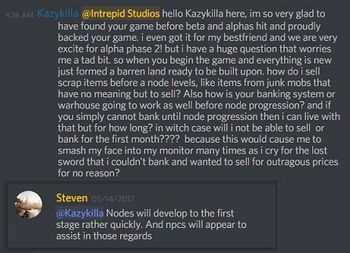
- ↑ Node series part II – the Metropolis.
- ↑

- ↑

- ↑ 36.0 36.1 訪談, 2020-07-18 (10:04).
- ↑ 37.0 37.1 訪談, 2020-07-08 (1:00:15).
- ↑ 直播, 2017-11-17 (55:27).
- ↑
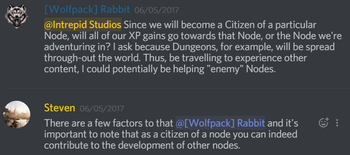
- ↑ 40.0 40.1 直播, 2017-05-26 (28:16).
- ↑ 41.0 41.1 直播, 2023-04-07 (58:39).
- ↑ 42.0 42.1 42.2 影片, 2023-03-31 (14:20).
- ↑ 43.0 43.1 影片, 2023-03-31 (12:47).
- ↑ 44.0 44.1 44.2 44.3 訪談, 2018-10-20 (2:36:25).
- ↑ 直播, 2018-01-18 (39:08).
- ↑ MMOGames interview, January 2017
- ↑ 47.0 47.1

- ↑ 直播, 2021-03-26 (1:12:51).
- ↑ 直播, 2020-07-25 (1:50:20).